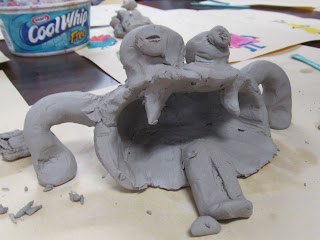It's that time of year! Germs are everywhere. People are sneezing and coughing-yuck! Fourth graders used germs as inspiration for a clay project. The first week the learning target was "I can use sketching to generate ideas." We looked at pictures of germs taken under a microscope as well as a handful of images of artist interpretations of germs. Students made six sketches of germs. The following week we discussed how artists can either use one sketch or combine elements of many to create a final product. The students were excited to turn their sketches into clay masterpieces. The clay germs began as pinch pots on their side. We had a quick review our learning target "I can explore clay skills: hollowing, pinching, slab and attaching two pieces of clay" the students were off! Our germs ended up with teeth, multiple eyes, tongues, arms-imaginations ran wild! After drying for a week the germs will go into the kiln, fired and be ready to glaze!
I saw this great idea on John Post's art education website.
Welcome to Phippsburg Elementary School's art room blog! In the art room at Phippsburg Elementary we learn oodles about art and create doodles (among other things) that showcase the creativity and talents of Phippsburg students.
Friday, March 8, 2013
You've Got to Move It, Move It
Keith Haring was a subway artist whose lively characters are still popular today. Fifth graders learned about his life and then did two projects inspired by his work. Their learning target for these lessons was "I can recognize positive and negative space in an artwork."
The first lesson was a group mural. We reviewed how to draw people in proportion and students drew a contour line of a person in action on cardstock. They cut out their people and used craypas to color around their shape: the negative space. Students repeated their shape several times on two murals.
The next project was about recognizing positive space. Students looked at more of Keith Haring's work and noticed how, in order to have action all around, he actually had active people on all four sides. In order to achieve a similar look, students were asked to turn their papers as they drew to create action all over. This time they added color to the figures: the positive space. They had fun adding the "action" lines. I think the results get you moving!
Winter Cardinals
Third and fourth graders discussed birds and what makes some birds more visible than others. The most common response was the bird's bright color that stands out from the colors around it. Cardinals are a perfect example of this. The lesson's learning target was "I can choose the right brush for the job." Students have been fine tuning their painting skills and need to recognize when to use a big brush or a small brush in their work. Our motto is "big space=big brush" and "little space=little brush." Students were asked to paint a cardinal in a tree and outline it. The students were asked to remember our painting motto and make good choices in which brush to use.
As you can see the students did a wonderful job not only in their brush choice, but in their compositions as well.
This lesson was inspired by the blog Deep Space Sparkle
http://www.deepspacesparkle.com/
The Mitten Tree
Winter in Maine requires mittens! Students in kindergarten and first grade listened to the book The Mitten Tree. The Mitten Tree is a story of an elderly woman who secretly knits mittens for children who don't have them. She hangs them on a tree at the children's bus stop. After they heard the story the kindergarten used found objects to make a pattern on a piece of construction paper. Their learning target was "I can make a clear print using found objects." The students used pieces of cardboard, q-tips, and marker caps to print their patterns. Once the patterns were dry the students used stencils to create the mitten shape and texture rubbing plates to add interest to their backgrounds.

First graders listened to the same story, but their learning target was "I can create tints of a color by adding white." They used their tints to create a page of patterns. Once their pattern was dry they cut out the mittens and added interest to the background with textured rubbing plates.
Subscribe to:
Comments (Atom)


















